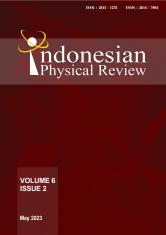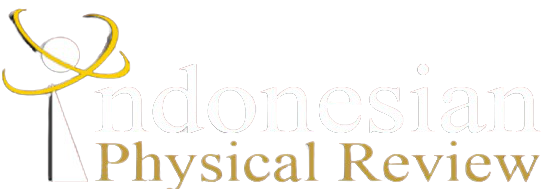INVESTIGATION OF THE GEOTHERMAL RESOURCE POTENTIAL USING GEOELECTRICAL METHOD WITH THE WENNER CONFIGURATION: A CASE STUDY IN LEBONG REGENCY, INDONESIA
DOI:
10.29303/ipr.v6i2.225Downloads
Abstract
In geothermal reservoirs, hydrothermal distribution is significant. The most widely utilized geothermal reservoirs to date are those of hydrothermal systems, which are geothermal systems where the reservoir contains steam, water, or a mixture of both, depending on the pressure and temperature of the reservoir. One of geophysical method that is enough to map subsurface conditions to determine the hydrothermal distribution is the 2-Dimensional Geoelectric method using the Wenner configuration. This method aims to study the variation of rock resistivity below the earth's surface, resulting in a two-dimensional profile of the subsurface resistivity model used to describe the layered subsurface resistivity structure. The results are in the form of 2-Dimensional modeling of the distribution of hydrothermal manifestations with data processing using pyGIMLI (Python Library for Inversion and Modeling in Geophysics) software. In the study area  Pungguk Pedaro Village, Bingin Kuning District, Lebong Regency, the Hulusimpang Formation has a high alteration intensity, as evidenced by the weathering in rocks and the micrographic appearance. The types of stones found in this research area include andesite rocks, including sandy gravel, volcanic breccia, tuff, andesite, basalt, basalt-andesite sand, silty sand, and clay. Or rocks derived from acidic magma.Keywords:
Geothermal; Hydrothermal; Resistivity; pyGIMLI; Hulusimpang FormationReferences
F. Y. Chaidir, O. D. Puspita, G. Rumahorbo, and H. Hamdalah, “Analysis of Geomagnetic and Geoelectric Data to Identify the Potential of Gold Deposits (Case Study: Randu Kuning, Wonogiri, Central Java),†IOP Conf. Ser. Earth Environ. Sci., vol. 830, no. 1, 2021, doi: 10.1088/1755-1315/830/1/012052.
F. Tarmidzi and A. Setyawan, “Study of fluid flow in gedongsongo temple manifestation geothermal based on the data of geophysics,†Energy Procedia, vol. 47, pp. 101–107, 2014, doi: 10.1016/j.egypro.2014.01.202.
A. Purwanto, J. P. Mipa, F. Keguruan, and U. Bengkulu, “Analisis Data Suhu , Konduktifitas , Dan Aliran Panas Untuk Menafsir Struktur Bawah Permukaan Daerah Air Putih Lebong Utara,†vol. 3, no. 2, pp. 252–256, 2007.
N. S. Sianturi, “Identifikasi Sebaran Panas Bumi Dengan Metode Geolistrik Tahanan Jenis, Identifikasi Sebaran Panas Bumi Dengan Menggunakan Metode Geolistrik Tahanan Jenis,†Universitas Bengkulu, 2018.
F. M. W. R, Carsten Rücker, Thomas Günther, “Rücker, C, Günther, T, & Wagner, F.M. (2017). pyGIMLi An Open-Source Library for Modelling and Inversion In Geophysics. Computers & Geosciences, 109, 106–123..pdf.†ELSEVIER, Germany, pp. 106–123, 2017.
R. W. Van Bammelan, The Geology of Indonesian. 1949.
& R. P. Gafoer, s., T.C. Amin., Peta Geologi Lembar Bengkulu, Sumatera. 1992.
Yulihanto, Structural Analysis Of The Onshore Bengkulu Forearc. Indonesian Petroleum Association, 1995.
B. Sapiie, “Geology and Tectonic Evolution of Fore-Arc Basins: Implications of Future Hydrocarbon Potential in the Western Indonesia,†2015.
S. Gafoer, T. Amin, and R. Pardede, Peta geologi lembar Bengkulu, Sumatera: Geological map of the Bengkulu quadrangle, Sumatera. Bandung: Pusat Penelitian dan Pengembangan Geologi, 2007.
L. Hendrajaya and I. Arif, “Monograf, Geolistrik Tahanan Jenis,†Lab. Fis. Bumi, Jur. Fis. FMIPA ITB, Bandung, 1990.
R. . Loke, M.H. and Barker, “Rapid least-squares inversion of apparent resistivity pseudosections by a quast-Newton method,†Geophys. Prospect., 1996.
J. M. Reynolds, An Introduction to Applied and Environmental Geophysics. 1997.
Telford.W.M., Geldart.L.P., and Sheriff.R.E., Applied geophysics, vol. 127, no. 3212. 1990. doi: 10.1038/127783a0.
S. Suparno, “Energi Panas Bumi. A present from the heart of the earth,†Univ. Indones. Depok, pp. 13–26, 2009.
N. M. Saptadji, “Karakterisasi Reservoir Panas Bumi,†Bandung Inst. Teknol. Bandung, vol. Juli, pp. 6–17, 2009.
License

This work is licensed under a Creative Commons Attribution-NonCommercial-ShareAlike 4.0 International License.
Authors who publish with Indonesian Physical Review Journal, agree to the following terms:
- Authors retain copyright and grant the journal right of first publication with the work simultaneously licensed under a Creative Commons Attribution-ShareAlike 4.0 International Licence (CC BY SA-4.0). This license allows authors to use all articles, data sets, graphics, and appendices in data mining applications, search engines, web sites, blogs, and other platforms by providing an appropriate reference. The journal allows the author(s) to hold the copyright without restrictions and will retain publishing rights without restrictions.
- Authors are able to enter into separate, additional contractual arrangements for the non-exclusive distribution of the journal's published version of the work (e.g., post it to an institutional repository or publish it in a book), with an acknowledgment of its initial publication in Indonesian Physical Review Journal.
- Authors are permitted and encouraged to post their work online (e.g., in institutional repositories or on their website) prior to and during the submission process, as it can lead to productive exchanges, as well as earlier and greater citation of published work (See The Effect of Open Access).





